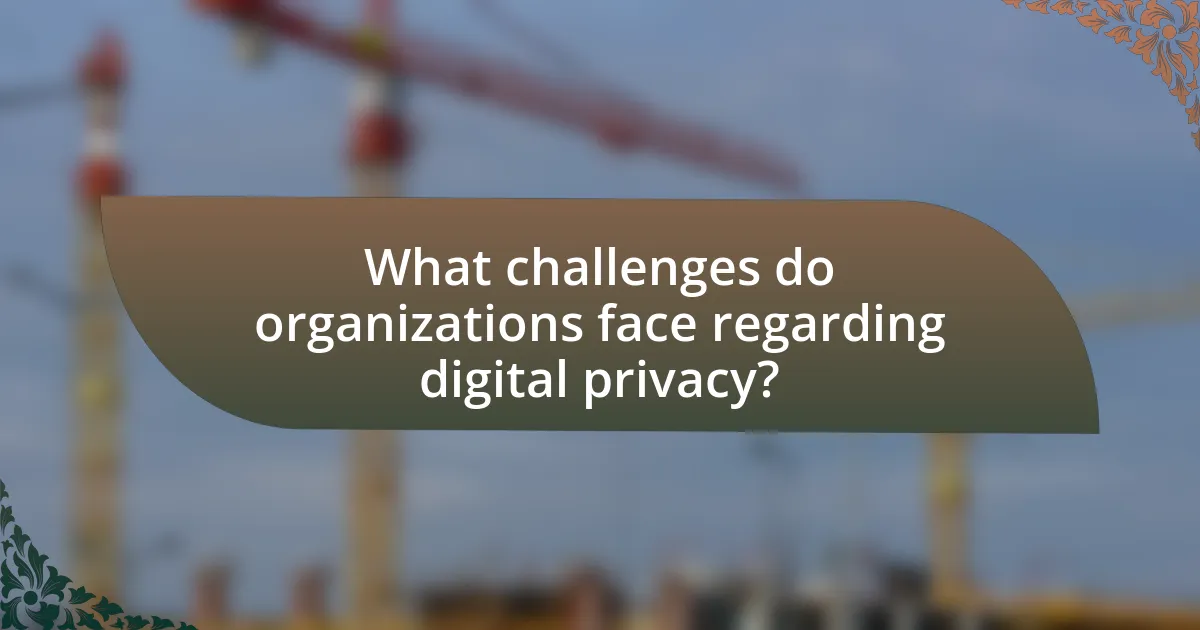The article examines the future of digital privacy in a hyper-connected world, highlighting the challenges posed by advancements in technology and data collection practices. It defines digital privacy as the right of individuals to control their personal information amidst pervasive data sharing and surveillance. Key components of digital privacy, such as data protection, user consent, encryption, and transparency, are discussed, along with the impact of hyper-connectivity on privacy risks. The article also addresses the growing importance of digital privacy due to rising data breaches, consumer expectations, and regulatory frameworks like the GDPR, while exploring the role of technology and best practices for individuals and organizations to enhance privacy protection.

What is the Future of Digital Privacy in a Hyper-Connected World?
The future of digital privacy in a hyper-connected world is increasingly uncertain, as advancements in technology and data collection practices continue to evolve. With the proliferation of Internet of Things (IoT) devices, personal data is being generated and shared at an unprecedented rate, leading to heightened concerns about surveillance and data breaches. According to a report by the International Association of Privacy Professionals, 79% of consumers express concern about how their data is being used, indicating a growing demand for stronger privacy protections. Additionally, regulatory frameworks like the General Data Protection Regulation (GDPR) in Europe are shaping how organizations handle personal data, but enforcement and compliance remain challenging. As technology advances, the balance between connectivity and privacy will require ongoing dialogue among stakeholders, including governments, businesses, and consumers, to establish effective safeguards.
How is digital privacy defined in the context of a hyper-connected world?
Digital privacy in the context of a hyper-connected world is defined as the right of individuals to control their personal information and maintain confidentiality in an environment where data is continuously shared across multiple platforms and devices. This definition encompasses the challenges posed by pervasive data collection, surveillance, and the potential for misuse of personal information by corporations and governments. According to a report by the Electronic Frontier Foundation, 90% of internet users express concern about their online privacy, highlighting the significance of digital privacy in today’s interconnected society.
What are the key components of digital privacy?
The key components of digital privacy include data protection, user consent, encryption, and transparency. Data protection involves safeguarding personal information from unauthorized access and breaches, which is essential given that over 4.1 billion records were exposed in data breaches in 2019 alone. User consent requires individuals to have control over their personal data, ensuring they are informed about how their information is used, as mandated by regulations like the General Data Protection Regulation (GDPR). Encryption secures data by converting it into a coded format, making it unreadable without the proper decryption key, which is crucial for protecting sensitive information during transmission. Lastly, transparency involves organizations being open about their data practices, allowing users to understand what data is collected and how it is utilized, fostering trust and accountability.
How does hyper-connectivity impact digital privacy?
Hyper-connectivity significantly compromises digital privacy by increasing the volume of data shared across interconnected devices and platforms. As more devices connect to the internet, they generate vast amounts of personal information, which can be collected, analyzed, and potentially misused by third parties. For instance, a report by the International Data Corporation (IDC) estimates that by 2025, the global data sphere will reach 175 zettabytes, much of which will include sensitive personal data. This proliferation of data creates more opportunities for breaches and unauthorized access, making individuals more vulnerable to privacy violations.
Why is digital privacy becoming increasingly important?
Digital privacy is becoming increasingly important due to the rising frequency of data breaches and the growing amount of personal information shared online. As of 2023, over 60% of individuals have experienced some form of data breach, highlighting the vulnerability of personal data. Furthermore, with the proliferation of smart devices and the Internet of Things, more data is being collected than ever before, leading to concerns about surveillance and misuse of information. The implementation of regulations like the General Data Protection Regulation (GDPR) in Europe underscores the necessity for stronger privacy protections, as individuals seek greater control over their personal data in a hyper-connected world.
What are the risks associated with poor digital privacy?
Poor digital privacy exposes individuals and organizations to significant risks, including identity theft, financial loss, and unauthorized surveillance. Identity theft can occur when personal information is accessed and misused, leading to fraudulent activities that can severely impact victims’ financial stability. According to the Federal Trade Commission, in 2020 alone, consumers reported losing over $3.3 billion to fraud, much of which stemmed from compromised personal data. Additionally, poor digital privacy can result in unauthorized surveillance, where third parties, including governments and corporations, monitor individuals’ online activities without consent, infringing on personal freedoms and privacy rights. This erosion of privacy can also lead to reputational damage and loss of trust in digital platforms, further complicating the landscape of digital interactions.
How do consumer expectations around privacy influence businesses?
Consumer expectations around privacy significantly influence businesses by driving them to adopt stricter data protection measures and transparency practices. As consumers increasingly prioritize their privacy, businesses must respond by implementing robust privacy policies and ensuring compliance with regulations such as the General Data Protection Regulation (GDPR), which mandates that companies protect personal data and uphold consumer rights. A survey by PwC found that 85% of consumers will not do business with a company if they have concerns about its security practices, highlighting the direct impact of privacy expectations on consumer trust and purchasing decisions. Consequently, businesses that prioritize privacy can enhance their reputation, foster customer loyalty, and gain a competitive advantage in the market.
What are the current trends shaping the future of digital privacy?
Current trends shaping the future of digital privacy include increased regulatory scrutiny, the rise of privacy-centric technologies, and growing consumer awareness. Regulatory bodies worldwide, such as the European Union with its General Data Protection Regulation (GDPR), are implementing stricter data protection laws, compelling companies to prioritize user consent and data security. Additionally, technologies like end-to-end encryption and decentralized data storage are gaining traction, providing users with more control over their personal information. Consumer awareness is also on the rise, with surveys indicating that a significant percentage of individuals are concerned about their online privacy, prompting businesses to adopt transparent data practices. These trends collectively indicate a shift towards a more privacy-conscious digital landscape.
How are emerging technologies affecting digital privacy?
Emerging technologies are significantly impacting digital privacy by increasing data collection and surveillance capabilities. For instance, advancements in artificial intelligence and machine learning enable organizations to analyze vast amounts of personal data, often without explicit consent. According to a 2021 report by the Electronic Frontier Foundation, the proliferation of Internet of Things devices has led to a dramatic rise in the amount of personal information being collected, which can be exploited for targeted advertising and other purposes. Additionally, technologies like facial recognition and biometric data collection raise concerns about unauthorized surveillance and the potential for misuse by both private companies and governments. These developments highlight the urgent need for robust privacy regulations to protect individuals in an increasingly interconnected digital landscape.
What role do regulations play in shaping digital privacy standards?
Regulations play a critical role in shaping digital privacy standards by establishing legal frameworks that dictate how personal data must be handled and protected. For instance, the General Data Protection Regulation (GDPR) implemented in the European Union sets stringent requirements for data collection, consent, and user rights, influencing global privacy practices. This regulation has prompted companies worldwide to enhance their data protection measures to comply with these standards, demonstrating the significant impact of regulatory frameworks on digital privacy.
How can individuals protect their digital privacy in a hyper-connected world?
Individuals can protect their digital privacy in a hyper-connected world by implementing strong security measures, such as using complex passwords, enabling two-factor authentication, and regularly updating software. These actions significantly reduce the risk of unauthorized access to personal information. For instance, a study by the Ponemon Institute found that organizations with two-factor authentication experienced 99% fewer account takeovers. Additionally, individuals should utilize virtual private networks (VPNs) to encrypt their internet traffic, making it more difficult for third parties to intercept data. According to a report from the Electronic Frontier Foundation, using a VPN can help safeguard personal information from ISPs and hackers. Lastly, being cautious about sharing personal information on social media and adjusting privacy settings can further enhance digital privacy.
What tools and practices can enhance personal digital privacy?
To enhance personal digital privacy, individuals can utilize tools such as Virtual Private Networks (VPNs), encrypted messaging apps, and privacy-focused web browsers. VPNs encrypt internet traffic, making it difficult for third parties to monitor online activities. Encrypted messaging apps, like Signal or WhatsApp, ensure that communications remain private and secure from interception. Privacy-focused web browsers, such as Brave or Firefox with privacy extensions, block trackers and ads, reducing data collection. According to a study by the Electronic Frontier Foundation, using these tools significantly decreases the risk of personal data exposure online, thereby reinforcing the importance of adopting such practices for improved digital privacy.
How can users stay informed about privacy policies and changes?
Users can stay informed about privacy policies and changes by regularly checking the privacy settings and policy sections of the websites and applications they use. Many organizations are required to notify users of significant changes to their privacy policies, often through email alerts or notifications within the service. Additionally, users can subscribe to updates from privacy advocacy groups or follow relevant news outlets that report on privacy issues. Research indicates that proactive engagement with privacy settings can enhance user awareness and control over personal data, as highlighted in studies by the Electronic Frontier Foundation.

What challenges do organizations face regarding digital privacy?
Organizations face significant challenges regarding digital privacy, primarily due to increasing regulatory requirements and evolving cyber threats. Compliance with regulations such as the General Data Protection Regulation (GDPR) and the California Consumer Privacy Act (CCPA) demands substantial resources and expertise, as non-compliance can result in hefty fines. Additionally, the rise of sophisticated cyberattacks, including data breaches and ransomware, poses a constant threat to the security of sensitive information. According to a report by IBM, the average cost of a data breach in 2023 was $4.45 million, highlighting the financial implications of inadequate digital privacy measures. Furthermore, organizations struggle with balancing user privacy with the need for data analytics, which can lead to ethical dilemmas and potential reputational damage. These factors collectively create a complex landscape for organizations striving to protect digital privacy in a hyper-connected world.
How do data breaches impact organizational privacy practices?
Data breaches significantly undermine organizational privacy practices by exposing sensitive information and prompting a reevaluation of data protection strategies. When a breach occurs, organizations often face regulatory scrutiny and reputational damage, leading to increased investments in cybersecurity measures and compliance protocols. For instance, the 2017 Equifax breach, which compromised the personal data of approximately 147 million individuals, resulted in the company spending over $1.4 billion on security enhancements and legal settlements. This illustrates how data breaches can catalyze a shift in privacy practices, compelling organizations to adopt more stringent data governance frameworks and enhance employee training on data protection.
What are the common causes of data breaches?
Common causes of data breaches include human error, malicious attacks, and system vulnerabilities. Human error accounts for approximately 30% of data breaches, often resulting from employees accidentally sending sensitive information to the wrong recipient or failing to secure devices. Malicious attacks, such as phishing and ransomware, are responsible for a significant portion of breaches, with phishing alone accounting for 22% of incidents according to the 2021 Verizon Data Breach Investigations Report. Additionally, system vulnerabilities, including outdated software and unpatched systems, create entry points for attackers, as evidenced by the 2020 SolarWinds breach, which exploited known vulnerabilities in widely used software.
How can organizations mitigate the risks of data breaches?
Organizations can mitigate the risks of data breaches by implementing robust cybersecurity measures, including encryption, access controls, and regular security audits. These strategies help protect sensitive information from unauthorized access and potential exploitation. For instance, according to the 2021 Verizon Data Breach Investigations Report, 61% of data breaches involved credential theft, highlighting the importance of strong access controls and multi-factor authentication. Additionally, conducting regular employee training on security awareness can reduce the likelihood of human error, which is a significant factor in many breaches. By adopting these practices, organizations can significantly lower their vulnerability to data breaches.
What ethical considerations arise in the realm of digital privacy?
Ethical considerations in digital privacy include the balance between individual rights and societal benefits, informed consent, data ownership, and the potential for surveillance. Individuals have the right to control their personal information, yet organizations often prioritize data collection for profit or security, raising ethical dilemmas. Informed consent is crucial; users must understand how their data is used, as evidenced by regulations like the General Data Protection Regulation (GDPR), which mandates transparency. Additionally, questions of data ownership arise, particularly regarding who has the right to access and utilize personal data. The potential for surveillance by governments and corporations further complicates these ethical issues, as it can infringe on personal freedoms and privacy rights.
How do companies balance user privacy with data monetization?
Companies balance user privacy with data monetization by implementing robust data protection measures while utilizing anonymization techniques. For instance, organizations often adopt privacy-by-design principles, ensuring that user consent is obtained before data collection and that data is aggregated to prevent identification of individuals. According to a 2021 report by the International Association of Privacy Professionals, 70% of companies that prioritize user privacy see improved customer trust, which can lead to increased revenue. This demonstrates that respecting user privacy can coexist with effective data monetization strategies.
What responsibilities do organizations have towards user data?
Organizations have a responsibility to protect user data by ensuring its security, privacy, and ethical use. This includes implementing robust data protection measures, such as encryption and access controls, to safeguard against unauthorized access and breaches. Additionally, organizations must comply with relevant data protection regulations, such as the General Data Protection Regulation (GDPR), which mandates transparency in data collection and processing practices. For instance, under GDPR, organizations are required to obtain explicit consent from users before collecting their personal data, reinforcing the importance of user autonomy and informed decision-making. Furthermore, organizations should regularly conduct audits and assessments to identify vulnerabilities and ensure compliance with data protection standards, thereby maintaining user trust and safeguarding their rights in an increasingly interconnected digital landscape.

What is the role of technology in shaping the future of digital privacy?
Technology plays a crucial role in shaping the future of digital privacy by enabling advanced data protection measures and fostering new privacy regulations. Innovations such as encryption, blockchain, and artificial intelligence enhance user control over personal data, making it more difficult for unauthorized entities to access sensitive information. For instance, end-to-end encryption ensures that only intended recipients can read messages, significantly reducing the risk of data breaches. Additionally, the implementation of privacy-focused technologies, like differential privacy, allows organizations to analyze data without compromising individual identities. As governments and regulatory bodies respond to technological advancements, laws such as the General Data Protection Regulation (GDPR) in Europe set stringent standards for data handling, further influencing how technology is developed and utilized in relation to privacy. These developments collectively indicate that technology is not only a tool for enhancing privacy but also a driving force behind evolving privacy norms and expectations in a hyper-connected world.
How do advancements in encryption technology enhance digital privacy?
Advancements in encryption technology enhance digital privacy by providing stronger methods to secure data against unauthorized access. Modern encryption algorithms, such as AES (Advanced Encryption Standard), utilize complex mathematical techniques that make it nearly impossible for attackers to decrypt data without the correct key. For instance, AES-256 encryption offers 2^256 possible keys, significantly increasing the difficulty of brute-force attacks. Additionally, advancements like end-to-end encryption ensure that only the communicating users can read the messages, preventing interception by third parties. This level of security is crucial in protecting sensitive information, as evidenced by the increasing adoption of encryption in messaging apps like Signal and WhatsApp, which have reported enhanced user trust and privacy protection due to these technologies.
What are the limitations of current encryption methods?
Current encryption methods face several limitations, including vulnerability to quantum computing, reliance on key management, and potential for human error. Quantum computers can break widely used encryption algorithms like RSA and ECC, rendering them ineffective against future threats. Additionally, key management issues, such as secure storage and distribution of encryption keys, can lead to unauthorized access if not handled properly. Human error, including poor password practices and misconfiguration, further compromises encryption effectiveness. These limitations highlight the need for ongoing advancements in encryption technology to ensure robust digital privacy in an increasingly interconnected world.
How can users implement encryption in their daily digital activities?
Users can implement encryption in their daily digital activities by utilizing end-to-end encrypted messaging apps, such as Signal or WhatsApp, which ensure that only the sender and recipient can read the messages. Additionally, users can encrypt their files and folders using software like VeraCrypt or BitLocker, which protects sensitive information from unauthorized access. According to a 2021 report by the Electronic Frontier Foundation, using encryption tools significantly reduces the risk of data breaches and enhances personal privacy online.
What impact do artificial intelligence and machine learning have on digital privacy?
Artificial intelligence and machine learning significantly impact digital privacy by enhancing data collection and analysis capabilities, which can lead to increased surveillance and potential misuse of personal information. These technologies enable organizations to process vast amounts of data quickly, allowing for more precise targeting in advertising and personalized services, but they also raise concerns about consent and data security. For instance, a study by the Electronic Frontier Foundation highlights that AI systems can analyze user behavior patterns, making it easier to identify individuals without their explicit consent, thereby infringing on privacy rights.
How can AI be used to improve privacy protection?
AI can improve privacy protection by utilizing advanced algorithms for data anonymization and encryption. These algorithms can effectively mask personal information, making it difficult for unauthorized entities to access sensitive data. For instance, techniques such as differential privacy allow organizations to analyze data trends without exposing individual user identities, thereby enhancing user confidentiality. Additionally, AI-driven systems can monitor and detect anomalies in data access patterns, alerting users and organizations to potential breaches in real-time. This proactive approach to security significantly reduces the risk of data leaks and unauthorized access, reinforcing the overall integrity of personal information in a hyper-connected environment.
What are the privacy risks associated with AI technologies?
AI technologies pose significant privacy risks, primarily through data collection, surveillance, and potential misuse of personal information. These systems often require vast amounts of data to function effectively, leading to concerns about unauthorized access and data breaches. For instance, a report by the Electronic Frontier Foundation highlights that AI can facilitate mass surveillance, enabling entities to track individuals without their consent. Additionally, AI algorithms can inadvertently reveal sensitive information through data inference, where seemingly innocuous data points are combined to uncover private details. The Cambridge Analytica scandal exemplifies how AI-driven data analytics can manipulate personal data for targeted political advertising, raising ethical concerns about consent and privacy.
What best practices can individuals and organizations adopt for better digital privacy?
Individuals and organizations can adopt several best practices for better digital privacy, including using strong, unique passwords and enabling two-factor authentication. Strong passwords reduce the risk of unauthorized access, while two-factor authentication adds an additional layer of security, making it significantly harder for attackers to compromise accounts. According to a 2021 report by the Cybersecurity & Infrastructure Security Agency, implementing two-factor authentication can block up to 99.9% of automated attacks. Additionally, regularly updating software and applications helps protect against vulnerabilities that could be exploited by cybercriminals. Organizations should also conduct regular privacy audits and employee training to ensure compliance with data protection regulations, such as the General Data Protection Regulation (GDPR), which mandates strict guidelines for data handling and user consent.
How can regular audits improve digital privacy measures?
Regular audits can significantly enhance digital privacy measures by systematically identifying vulnerabilities and ensuring compliance with privacy regulations. These audits evaluate data handling practices, assess security controls, and verify that organizations adhere to established privacy policies. For instance, a study by the International Association of Privacy Professionals found that organizations conducting regular audits were 30% more likely to identify and mitigate data breaches before they occurred. This proactive approach not only strengthens data protection but also fosters trust among users, as they see that organizations are committed to safeguarding their personal information.
What role does user education play in enhancing digital privacy?
User education plays a crucial role in enhancing digital privacy by equipping individuals with the knowledge and skills necessary to protect their personal information online. Educated users are more likely to understand the importance of strong passwords, recognize phishing attempts, and utilize privacy settings on social media platforms. Research indicates that organizations that implement user education programs see a significant reduction in security breaches; for instance, a study by the Ponemon Institute found that companies with effective security awareness training can reduce the risk of data breaches by up to 70%. This demonstrates that informed users can actively contribute to a safer digital environment, thereby enhancing overall digital privacy.




